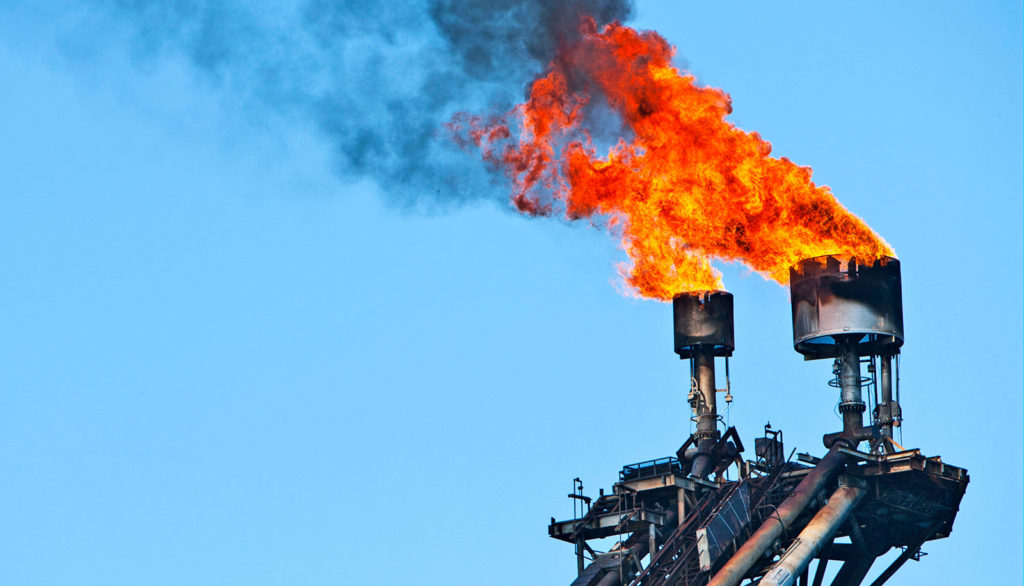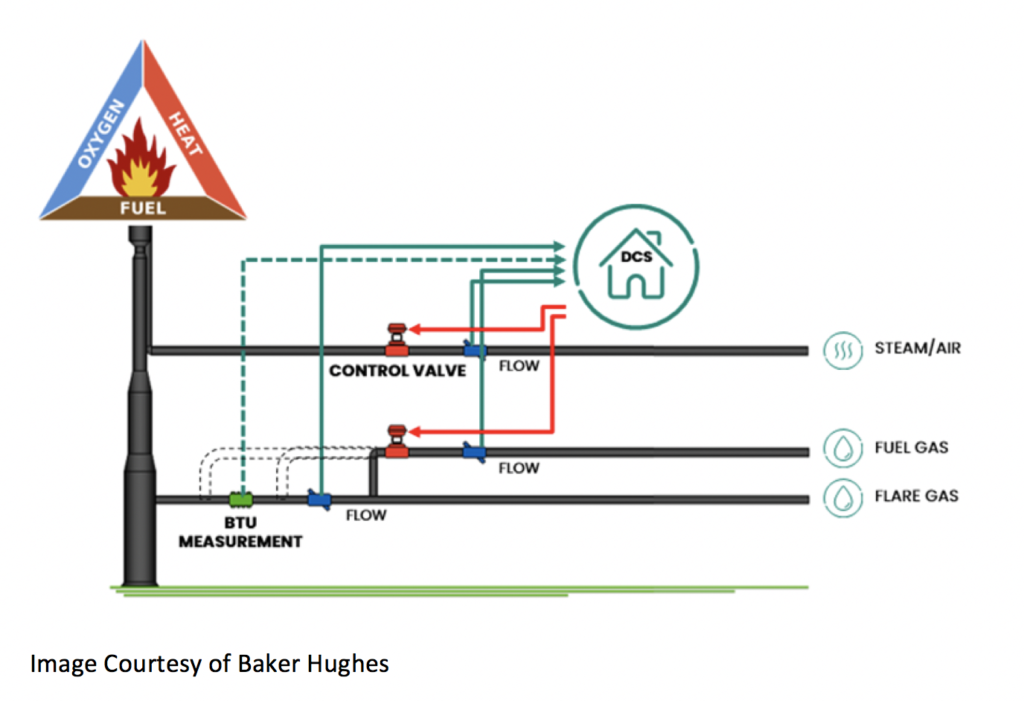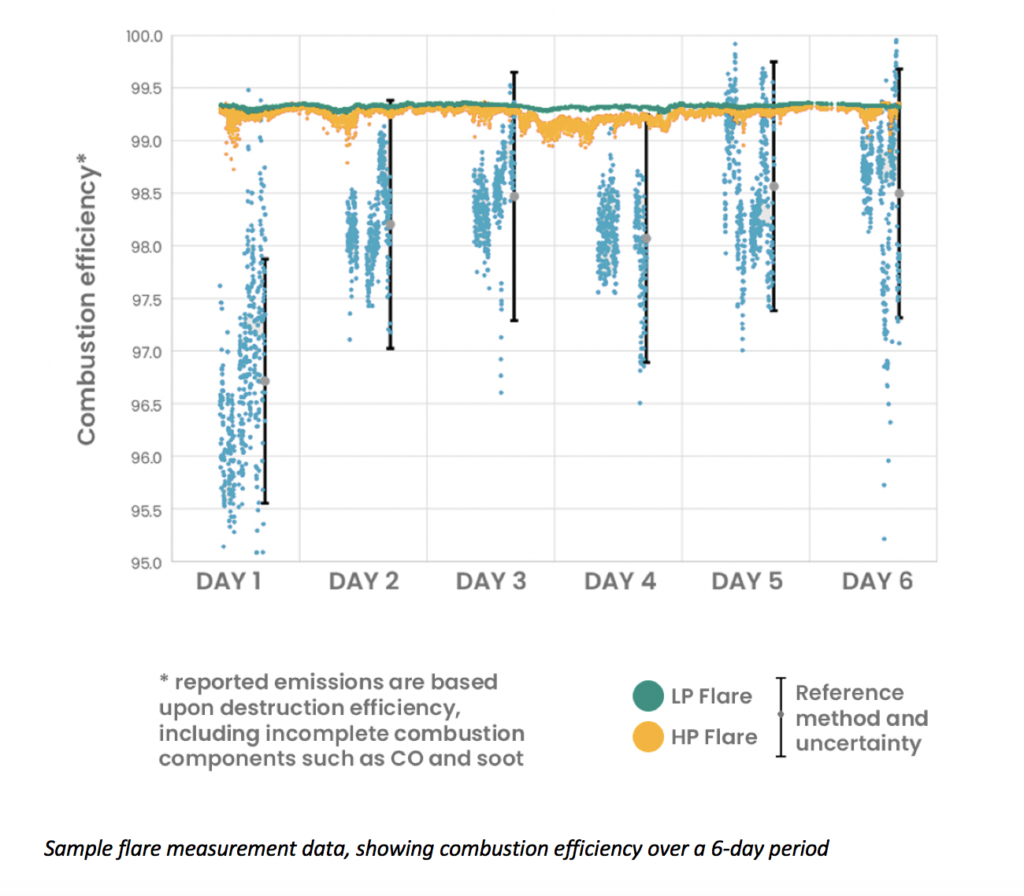
Analytics that calculate flare combustion efficiency based upon system design, gas composition and environmental factors such as wind speed can be used to track emissions.
Where this computation can be done in near real-time it creates the opportunity to moderate parameters in the flare to optimize the system including management of methane emissions.
How it Works
A flare system is designed to have an optimal combustion efficiency – generally in the 96.5% range or more – in order to transform all hydrocarbon gases post combustion into CO2 and other pollutants. However, it is also known that changes in the flow or composition of the flared gas, or changes to the environment can lead to reductions in the flare performance – as documented elsewhere in this tool.
Modern flares are often equipped with advanced analytical systems – tracking flow, temperature and composition (see earlier sections of the toolkit for details). By tracking these parameters in near real-time and combining the data with models it is possible to moderate the flare to maintain effective combustion.
While the average combustion efficiency in the Upstream assets tend to be high thanks to the relative stable hydrocarbon gas mixture with a high net heaving value, it can be different for Downstream assets. Indeed, the gas composition is subject to changes as well as its temperature with a much larger spectrum of net heating valueThe energy released as heat when a compound undergoes complete combustion with oxygen to form gaseous carbon dioxide and gaseous water (also referred to as lower heating value). Learn more…. To ensure an optimal combustion under these circumstances flare systems are often assisted using supplemental gas when the gas going to the flare is too lean and steam (or air) when the it is too rich. The key is to keep the optimal combustion also called the stoichiometric combustion where there’s the required mixture of fuel and oxygen. Flare systems that have access to supplemental gases therefore have a greater range of options for predictive feedback and controlThe inclusion of feedback systems into flare monitoring allows adjustments to be made to how the flare is operated to maintain good combustion efficiency. As many influences on flares are… Learn more… mechanisms.
To ensure a stochiometric combustion it is critical to have a permanent monitoring of the net heating value of the gas being flared in order to adjust the just needed amount of fuel gas and steam. With this information fed in the customer SCADA (or DCS) or calculated by predictive systems, smart software can live compute the data collected and determine the amount of fuel gas and steam required and send the set points to the respective flow control valves to get the needed mix. This can be illustrated as follow.

This set up allows the flare system to stay in compliance with the required high combustion efficiency and destruction and removal efficiency.
Advantages
Allows for short-term adaptations to the flare to accommodate changeable variables including core parameters such as composition or environmental effects such as wind speed
Maintains a constant and permanent record of interventions
Reduces the need for operator-led interventions or judgement-based decisions
Highlights long-term issues early and can be used to support maintenance programmes
Limitations
Can only operate where other advanced measurement systems are already installed – such as in-line composition analysis
Requires access to computation resources, either on the site itself or though sufficiently fast network links and cloud-computing
Validation of adaptations
Go Deeper
Case study
Abridged from ‘Measurement up, methane down: innovative flare management’ written by Baker Hughes
Measurement up, methane down: innovative flare management | Baker Hughes

The inclusion of feedback systems into flare monitoring allows adjustments to be made to how the flare is operated to maintain good combustion efficiency. As many influences on flares are transient - such as corsswinds, these systems need to operate in near real-time to afford the maximum benefits to the operation.